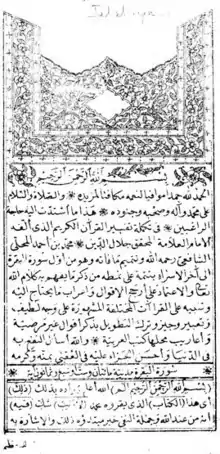Tafsir al-Jalalayn
Tafsīr al-Jalālayn (Arabic: تفسير الجلالين, lit. 'Tafsir of the two Jalals') is a classical Sunni interpretation (tafsir) of the Qur'an, composed first by Jalal ad-Din al-Maḥalli in 1459 and then completed after his death by his student Jalal ad-Din as-Suyuti in 1505, thus its name, which means "Tafsir of the two Jalals". It is recognised as one of the most popular exegeses of the Qur'an today,[1] due to its simple style[1] and its conciseness, as it is only one volume in length.
 The first page of "Tafsir al-Jalalayn" - Cairo edition | |
| Author | |
|---|---|
| Original title | تفسير الجلالين |
Tafsir al-Jalalayn has been translated into many languages including English, French, Bengali, Urdu, Persian, Malay/Indonesian,[2] Turkish, and Japanese. There are two English translations.[3][4]
See also
References
- Tafsir al-Jalalayn, Altafsir.com, accessed 16 March 2014
- The Qurʼān in the Malay-Indonesian world : context and interpretation. Daneshgar, Majid,, Riddell, Peter G.,, Rippin, Andrew, 1950-2016. Abingdon, Oxon. 2016-06-10. ISBN 9781317294757. OCLC 951623927.CS1 maint: others (link)
- Al-Mahalli and Al-Suyuti (2008). Tafsir al-Jalalayn. Translated by Dr. Feras Hamza. Louisville: Fons Vitae. ISBN 9781891785160.
- Al-Mahalli and Al-Suyuti (2007). Tafsir al-Jalalayn. Translated by Aisha Bewley. London: Dar al Taqwa. ISBN 978-1870582612.
External links
- Tafsir al-Jalalayn in Arabic (in kindle store)
- Tafsir al-Jalalayn in English (in PDF)
- Al-Quran project includes Tafsir of the two Jalals (Jalal al-Din al-Mahalli and Jalal al-Din al-Suyuti) with annotated interpretation.
- Tafsir al-Jalalayn (Arabic Text)
- Quran with Tafsir Al-Jalalayn
This article is issued from Wikipedia. The text is licensed under Creative Commons - Attribution - Sharealike. Additional terms may apply for the media files.
